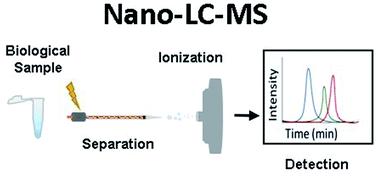当前位置:
X-MOL 学术
›
Anal. Methods
›
论文详情
Our official English website, www.x-mol.net, welcomes your
feedback! (Note: you will need to create a separate account there.)
Nano-liquid chromatography-mass spectrometry and recent applications in omics investigations.
Analytical Methods ( IF 2.7 ) Pub Date : 2020-08-21 , DOI: 10.1039/d0ay01194k Katherine L Sanders 1 , James L Edwards
Analytical Methods ( IF 2.7 ) Pub Date : 2020-08-21 , DOI: 10.1039/d0ay01194k Katherine L Sanders 1 , James L Edwards
Affiliation

|
Liquid chromatography coupled to mass spectrometry (LC-MS) is one of the most powerful tools in identifying and quantitating molecular species. Decreasing column diameter from the millimeter to micrometer scale is now a well-developed method which allows for sample limited analysis. Specific fabrication of capillary columns is required for proper implementation and optimization when working in the nanoflow regime. Coupling the capillary column to the mass spectrometer for electrospray ionization (ESI) requires reduction of the subsequent emitter tip. Reduction of column diameter to capillary scale can produce improved chromatographic efficiency and the reduction of emitter tip size increased sensitivity of the electrospray process. This improved sensitivity and ionization efficiency is valuable in analysis of precious biological samples where analytes vary in size, ion affinity, and concentration. In this review we will discuss common approaches and challenges in implementing nLC-MS methods and how the advantages can be leveraged to investigate a wide range of biomolecules.
中文翻译:

纳米液相色谱-质谱法及其在组学研究中的最新应用。
液相色谱与质谱联用 (LC-MS) 是识别和定量分子种类的最强大工具之一。将色谱柱直径从毫米级减小到微米级现已成为一种成熟的方法,可以进行样品有限的分析。在纳流状态下工作时,需要具体制造毛细管柱才能正确实施和优化。将毛细管柱与质谱仪耦合以进行电喷雾电离 (ESI) 需要减少后续的发射器尖端。将柱直径减小到毛细管规模可以提高色谱效率,并且发射器尖端尺寸的减小可以提高电喷雾过程的灵敏度。这种改进的灵敏度和电离效率对于分析珍贵的生物样品非常有价值,因为分析物的大小、离子亲和力和浓度各不相同。在这篇综述中,我们将讨论实施 nLC-MS 方法的常见方法和挑战,以及如何利用其优势来研究各种生物分子。
更新日期:2020-09-24
中文翻译:

纳米液相色谱-质谱法及其在组学研究中的最新应用。
液相色谱与质谱联用 (LC-MS) 是识别和定量分子种类的最强大工具之一。将色谱柱直径从毫米级减小到微米级现已成为一种成熟的方法,可以进行样品有限的分析。在纳流状态下工作时,需要具体制造毛细管柱才能正确实施和优化。将毛细管柱与质谱仪耦合以进行电喷雾电离 (ESI) 需要减少后续的发射器尖端。将柱直径减小到毛细管规模可以提高色谱效率,并且发射器尖端尺寸的减小可以提高电喷雾过程的灵敏度。这种改进的灵敏度和电离效率对于分析珍贵的生物样品非常有价值,因为分析物的大小、离子亲和力和浓度各不相同。在这篇综述中,我们将讨论实施 nLC-MS 方法的常见方法和挑战,以及如何利用其优势来研究各种生物分子。











































 京公网安备 11010802027423号
京公网安备 11010802027423号